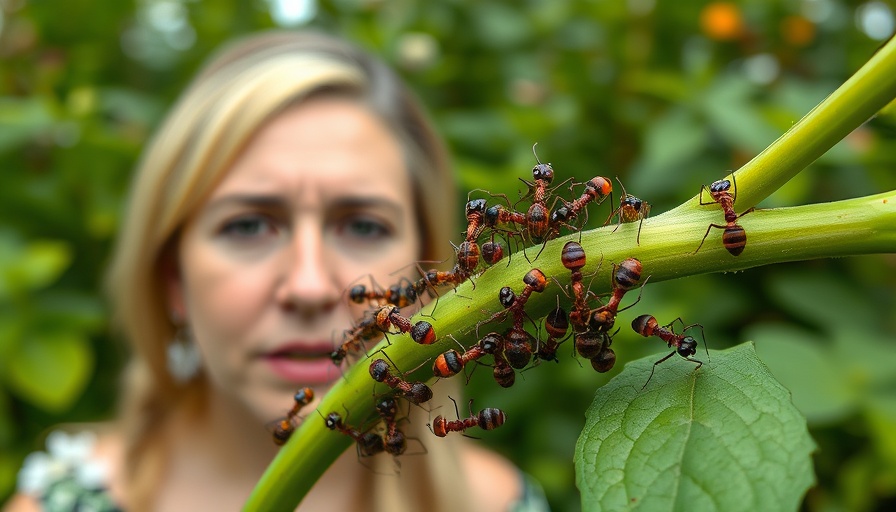
Ants and Their Impact on Your Garden
When we think of ants in our gardens, we often see them as pesky intruders; however, they play a significant role in enhancing soil quality and promoting plant growth. Understanding the dual roles that ants play—both as contributors to a healthy ecosystem and as potential pests—can help you make informed decisions about their presence in your garden.
In the insightful video "Ants in the Garden: Pest Patrol or Aphid Ranchers?", various aspects of ant behavior and their dual role in gardens are discussed, prompting a closer look at the complexities of their impact on horticulture.
The Positive Side of Ants: Natural Garden Helpers
Firstly, ants can be excellent allies for gardeners. Their tunneling activities aerate the soil, improving nutrient cycling and enhancing water infiltration. According to a 2011 study, ants and termites contributed to a remarkable increase of 36% in wheat yields, highlighting their vital role in nutrient dynamics.
Moreover, ants can also act as natural pest controllers. They feed on harmful insects or even manage pest populations by defending beneficial plants. This behavior can create a balance in your garden ecosystem, making it more resilient against infestations.
When Ants Become a Problem: Understanding the Dark Side
However, not all interactions with ants are beneficial. They can develop mutualistic relationships with harmful pests like aphids and mealybugs, protecting and farming them in exchange for sugary secretions like honeydew. In a scenario where ants are heavily protecting aphids, their presence can drive away beneficial pollinators such as bees and butterflies, ultimately affecting flower and fruit production.
Another concern arises when ants disrupt root systems in raised beds or container gardens, leading to nutrient deprivation. In such enclosed spaces, their tunneling can result in air pockets that draw moisture away from plant roots, often causing the plants to suffer.
How to Manage Ant Populations in Your Garden
If you find that ants are causing more harm than good in your garden, it’s essential to establish control measures. Myths about certain control strategies, like the supposed efficacy of boiling water, are not only ineffective but can exacerbate the issue. Instead, consider using traditional methods like borax mixed with sugar or peanut butter, which can attract and eliminate ants effectively.
For those concerned about pets or children being around chemicals, it’s important to place these baits in less accessible areas. Diatomaceous earth offers another solution, but remember that it loses effectiveness when wet, so placement is key.
The Role of Ants in Peonies and What Gardeners Should Know
A common misconception is that ants are essential for peony blooms. While they do visit peonies for the sugars released by the bulbs, their presence does not affect blooming directly. An article by the University of Wisconsin emphasizes that peonies can thrive without ants, underscoring the role of ants as opportunists rather than necessary helpers.
Enhancing Ant Populations for Soil Health
If your aim is to benefit from ants rather than eradicate them, consider strategies that encourage their presence without their harmful practices. Gardeners can use wood mulches which not only support healthy ant populations but also prevent disruptions in soil structure. Moreover, planting "extra floral nectar" plants that attract ants can help divert them from the more vulnerable crops.
For instance, species like sunflowers or passion fruit vine can effectively attract ants and keep them away from your vegetable patches.
The Verdict: Are You Team Ant or Not?
As you assess the role of ants in your garden, consider your overarching gardening goals. Do you prioritize soil health and natural aeration, or are you striving for high yields of specific plants? It’s essential to recognize that while ants can be incredibly beneficial, they can also adopt more parasitic roles depending on the garden environment.
Your tone and actions toward ants will directly influence your garden's ecosystem. You can cultivate a healthier balance by understanding how their presence can be optimized for the betterment of your green space.
Transitioning Forward with Ant Awareness
In the insightful video "Ants in the Garden: Pest Patrol or Aphid Ranchers?", various aspects of ant behavior and their dual role in gardens are discussed, prompting a closer look at the complexities of their impact on horticulture.
If you would like to delve deeper into how to harness the benefits of ants in your garden, consider implementing some of the strategies discussed. A well-informed approach can turn potential challenges into opportunities. Happy gardening!
 Add Row
Add Row  Add
Add 




Write A Comment